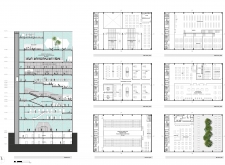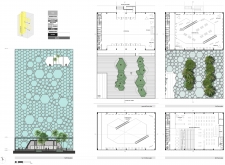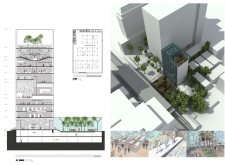5 key facts about this project
The design represents a progressive approach to architecture, emphasizing sustainability and user-centric experiences. By prioritizing natural light, the project creates inviting spaces that encourage movement and engagement. The extensive use of glass throughout the façade enhances this goal, allowing views into and out of the building, while also promoting a sense of transparency and openness. Moreover, the unique hexagonal pattern of the building's exterior not only contributes to its visual appeal but also optimizes energy efficiency through passive solar design.
In terms of function, the architectural spaces are carefully organized to cater to different user groups. Educational areas are designed for flexibility, featuring movable partitions that allow for diverse learning environments. This adaptability supports both individual study and group collaboration, making the spaces versatile for various educational activities. The hospitality sections, including a café and a restaurant, are intended not just to serve food but to act as social hubs where members of the community can gather, enhancing the project’s role in public life.
Significant attention has been paid to the materiality of this architectural project, showcasing a thoughtful selection of sustainable materials that align with the overarching design philosophy. Glass is used extensively to facilitate transparency and to capitalize on natural light, thereby reducing the need for artificial lighting. Aluminium is employed in the structural framework, providing a lightweight yet durable option that reduces the building's overall energy consumption. Concrete is used strategically in areas requiring strength and stability, ensuring longevity and robustness. Furthermore, the landscaping features native plants that not only support biodiversity but also minimize water usage, reinforcing the project’s commitment to environmental sustainability.
The architectural design takes into account the surrounding environment, integrating green terraces that contribute to the overall ecological performance of the building. These outdoor areas not only serve as extensions of the interior spaces but also promote social interaction and well-being among visitors. By enhancing the site with such landscaping elements, the project aligns itself with biophilic design principles, connecting users to nature and fostering a healthier atmosphere.
Unique design approaches found in this project include its innovative spatial organization, which allows for fluid transition between spaces. The seamless integration of various functions encourages users to explore the building holistically rather than as isolated units. Additionally, the construction techniques employed reflect an efficiency-focused mindset that seeks to minimize waste and leverage sustainable practices, ensuring that the project is not only aesthetically pleasing but also environmentally responsible.
This architectural project, with its clear intent and sophisticated design, exemplifies how modern architecture can serve practical needs while promoting sustainability and community interaction. The various elements, from the educational spaces to the hospitality areas and innovative materials, provide layers of meaning and function that resonate well with contemporary architectural ideals. For those interested in understanding more about this project, including detailed architectural plans, sections, and designs, a deeper exploration is encouraged. Engaging with these elements will offer further insights into the thoughtful design ideas that shape this significant architectural endeavor.


























